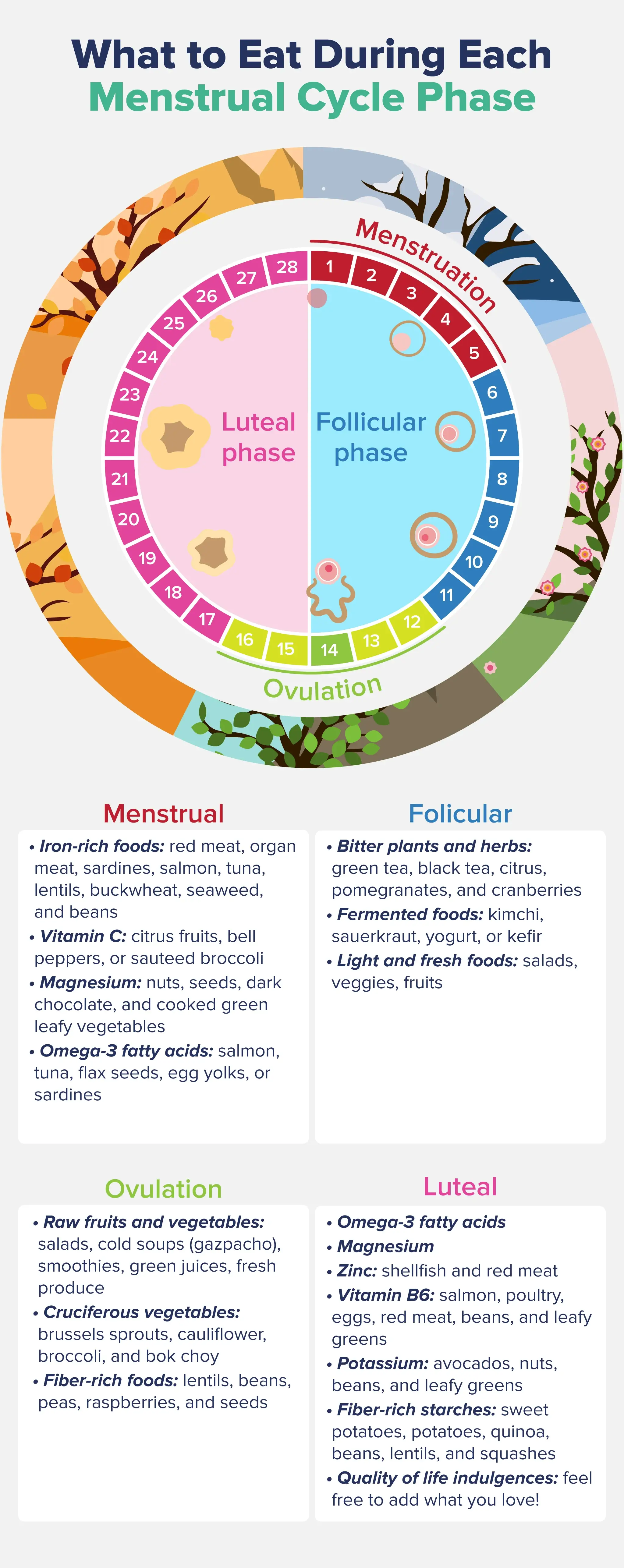Save $40 on your initial consult with a TNI Dietitian!
Talk to a real Dietitian for only $99: Schedule Now
This post contains links through which we may earn a small commission should you make a purchase from a brand. This in no way affects our ability to objectively critique the products and brands we review.
Evidence Based Research To fulfill our commitment to bringing our audience accurate and insightful content, our expert writers and medical reviewers rely on carefully curated research.
Read Our Editorial Policy
Cycle syncing involves changing what you eat, how you exercise, and what activities you do based on the stage of your menstrual cycle.
Although the research is very limited in this area, many menstruating women report that syncing their cycles to their food and activity helps with pre-menstrual symptoms or improves how they feel throughout their cycle.
In this article, we’ll focus on the nutrition part of cycle syncing (stay tuned for Part 2, which is all about syncing your exercise routines), including which foods are best to eat during each of the four menstrual phases.
Get a weekly menu, grocery list, macros—one consult unlocks it all.
Get a weekly menu, grocery list, macros—one consult unlocks it all.

First things first: if you thought “menstrual cycle” just meant when you’re on your period, keep reading!
There are four phases of the menstrual cycle:1
Here’s a quick look at what’s going on with your primary reproductive and fertility-related hormones at each stage of the menstrual cycle:2
| Cycle Phase | Hormonal Changes |
| Menstrual (Cycle Day ~1-5) | All hormones (estrogen, progesterone, LH, FSH, testosterone) are at their lowest. |
| Follicular (Cycle Day ~5-14) | Estrogen increases, reaching its peak at the latest follicular stage. |
| Ovulatory (Cycle Day ~14-17) | Hormones are at their highest: Luteinizing hormone (LH) and follicle-stimulating hormone (FSH) surge. Testosterone is likely at its highest just before or at ovulation. |
| Luteal (Cycle Day ~17-28) | Progesterone levels rise to their peak, and estrogen slightly rises again. |
Although lab testing is the only way to truly know where your hormones are during each cycle stage, you can generally gauge things by tracking your cycle.
Many apps allow you to easily track the dates of your period, which can estimate when you ovulate. However, many people don’t ovulate exactly halfway through their cycle.
Products like Oura Ring and Natural Cycles use morning basal body temperature to estimate ovulation better. Alternatively, you can buy LH test strips (ovulation test strips) to see when your LH surges (a good indication of ovulation).
Okay, now that we know what happens during each phase of the menstrual cycle, how can we change our diet to optimize our feelings and functions?

As most women who have periods know, the menstrual phase typically brings lower energy and mood changes due to lower hormone levels. In this phase, estrogen and progesterone are at their lowest, causing you to crave rest and relaxation.
Many people refer to the four phases as the four seasons with the menstrual phase represented as winter. In winter, you may want to stay indoors, cozy up, relax, and eat warm foods.
However, we don’t want to entirely go off the rails by eating only less nutritious foods. Eating adequate amounts of lean proteins and healthy fats can balance your blood sugar, which can help balance your mental health and energy throughout your period.
Plus, consuming enough amino acids and healthy fats sets the stage for healthy ovulation in the upcoming cycle, as these nutrients are building blocks for hormone synthesis.
Menstruating causes blood loss and lower iron levels, so replenishing your iron and mineral stores is ideal during this time.3
You’ll also want to emphasize cooked and warming foods and spices (like ginger, teas, cooked veggies, and soups) that are nourishing and nutrient-dense.
Bloating is more common during this phase, so you may want to avoid an abundance of raw veggies and salads, which can be more difficult to digest.
Some ideal foods to eat during the menstrual phase include those rich in :
The follicular phase reflects our inner “spring”—the snow is melting, the sun is coming out, and hormones, mood, and energy levels are rising.
Like springtime meals, follicular phase cycle syncing involves lighter fare like salads and plenty of fresh, raw foods.
During this phase, metabolic rates and energy expenditures are lower, meaning that higher calorie intake at this time may lead to unwanted weight gain.6
Cortisol levels may also be higher in this phase, so limiting your intake of caffeine, alcohol, and sugar may be beneficial.7
Eating bitter or astringent foods can also benefit the follicular phase, as they help with liver function and detoxify excess hormones like estrogen.
Here are some foods to focus on during the follicular phase:
Light and fresh foods: Salads, veggies, fruits
Ovulation is compared to summer, as most women feel their absolute best and sunniest during this two- or three-day period.
Estrogen rises, and LH levels surge, making you feel happier, more energetic, and more social.
However, some people can have estrogen surges that go too high, which leads to symptoms like acne, anxiety, mood swings, irritability, or cramping.
If this sounds like you, you may want to eat foods that can help to eliminate excess estrogen, like cruciferous vegetables, which can help to metabolize extra estrogen and prevent it from getting stored in the body.8
According to Traditional Chinese Medicine (TCM) practices, ovulation is a “hot” phase of the cycle—which makes sense, as our basal body temperatures rise by 0.5 to 1°F after we ovulate.9
TCM practices recommend mainly eating raw and cold foods during ovulation to “balance out” the “hot” qualities of the phase. These foods include salads, smoothies, green juices, and other raw foods. If you’re ever going to go to a raw vegan restaurant, now is the time!
Like the follicular phase, your metabolism is still slower until after you ovulate, so you may feel more satisfied with lighter foods now than you do during the luteal and menstrual phases.
Some ovulatory phase-friendly foods include:
The luteal phase is our internal autumn, which is when we start to hunker down and prepare for winter. This includes needing more calories than we do in the follicular and ovulatory phases.
We need more calories in the luteal phase because our metabolic rate and energy expenditure increase, so you want to ensure you’re providing your body with enough energy and nutrients.10
If you experience more cravings and increased appetite in the week or two before your period, you’re not imagining it—your body is burning more calories at rest, causing you to be hungrier to meet those needs.
You also use more B vitamins (especially B6) during the luteal phase to support higher progesterone production, so replenish them with foods like salmon, poultry, eggs, red meat, beans, and leafy greens.
Slow-burning, fiber-rich carbohydrates (like beans and lentils) will help keep blood sugar and energy stable, and minerals like magnesium should be emphasized.
There are many ideal foods to eat during the luteal phase, as this is when you can prevent or lessen those unwanted PMS (premenstrual syndrome) symptoms. Here’s which nutrients to focus on:
No research shows that cycle syncing works, but that doesn’t mean it can’t. Everyone’s menstrual cycle is vastly different, so it may not work for all people. That said, if you experience any PMS or menstrual symptoms, trying to adopt some of these nutritional changes could be a low-risk, high-reward scenario. Adding in extra nutrients is (hardly) ever a bad thing, so cycle tracking for a few months and making these changes could help you feel better.
It depends on which phase of your cycle you are in. Briefly, here are the foods to try eating in each phase:
• Menstrual: Foods rich in iron (red meat, legumes), omega-3s (fatty fish), magnesium (nuts, seeds, dark chocolate), and vitamin C (citrus, bell peppers)
• Follicular: Lighter foods like salads and smoothies; bitter plants and herbs; fermented foods
• Ovulatory: Fresh, raw fruits and vegetables; cruciferous veggies; fiber-rich foods (lentils, beans, veggies, fruits)
• Luteal: Hearty, carbohydrate-dense foods (sweet potatoes, squash, lentils, beans), healthy fats, zinc (shellfish, red meat), magnesium (nuts, seeds, greens), vitamin B6 (salmon, poultry, red meat), and potassium (avocados, bananas)
There is no research to suggest that cycle syncing balances hormones, but it’s possible, especially if you have higher estrogen levels. Foods rich in fiber and cruciferous vegetables are thought to help with estrogen metabolism and detoxification.
Yes, some phases of the cycle are better suited than others for building muscle, particularly the follicular phase.